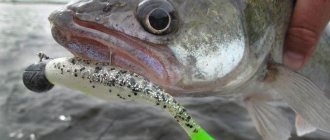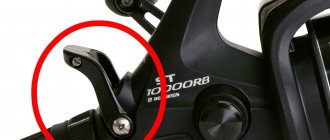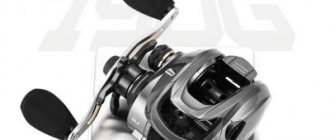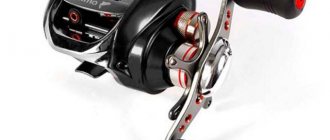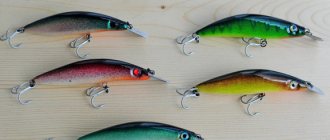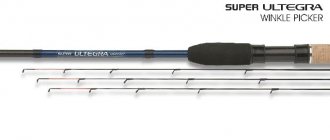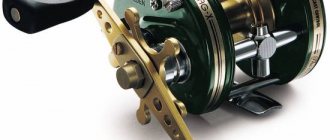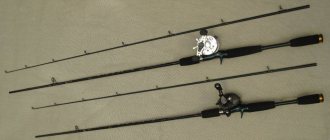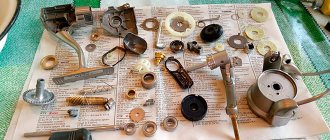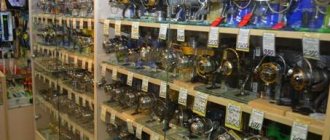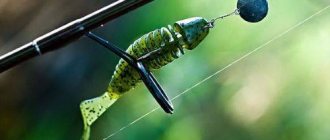Jig reel
There is no doubt that jig is the most popular type of spinning fishing among our anglers.
But other than that, this is perhaps the easiest way to catch trophy predatory fish. Despite the fact that it would seem that catching a fish with a jig is not difficult, in practice it is a creative type of fishing, which is not always limited to the classic “two turns of the reel and a pause.” The key to success, in addition to knowing the habits of the fish and the correct presentation of the bait, is also competent and balanced tackle, in which the reel is of key importance. Every year, thousands of beginning fishermen, mastering jig fishing, ask the same question:
Inertia in jig fishing
Among the great variety of modern gear, two “directions” can be clearly distinguished - inertialess, or meat grinder, and casting, or cartoon. All this is wonderful, but sometimes there is a lack of a third direction, which is much forgotten, but allows you to perform such wiring that none of the types of modern multipliers and especially spinning reels are capable of. We are talking about the good old “wheel”, or inertial coil. Let me make a reservation right away, we will talk about the Nelma inertial coil. Not because other reels of this type are bad, no. The fact is that the revival of these models began precisely after the appearance of “Nelma” on our market, that’s all.
Are there many spinning anglers who still fish with such old designs that have become popular again? It is extremely difficult to answer this question; there are no statistics, so I’ll just say – a lot. It is especially common to see a fisherman with this type of reel in the outback, where modern developments reach later than everyone else. For example, in Siberia. And if fishermen there are forced to use the “wheel” for various reasons, one of which is a meager financial situation, then we, the residents of Central Russia, frankly speaking, spoiled by all sorts of “know-how,” have to use inertial reels for completely different reasons.
Firstly, the unpretentiousness of the mechanism itself. If you drop an expensive inertia-free device into water, sand, dust, grass, it means that upon arrival home it must be opened and dried/lubricated. I'm not talking about the multiplier, it should not be placed in the above conditions at all - the slightest touch of dirt, and the endless screw can be changed. This is a huge disadvantage, second only to the price. “Nelma” doesn’t give a damn (excuse the pun) where it lies - even in the mud, it’s enough to wash and blow it through - and it’s back in combat readiness, like a Kalashnikov assault rifle. This can be seen more than once in one of the videos that the Internet is so replete with. Many may think it’s a publicity stunt, nothing more. I thought so until I personally took the “Nelma” from a friend of his and drove it around in the sand, after which I cast it. The ounce jig flew exactly the same distance as before the experiment. At the same time, the coil did not make any extraneous noise, except for the painfully beating sand, which flew out from under the coil drum at great speed.
Secondly, a really soft and smooth ride. And again this can be seen in the videos about “Nelma”. A thin cord comes off the reel drum under its own weight, but with one condition - the reel must be rolled out, that is, it must have been in real fishing at least once. And again I confirm with my own spectacle. If we compare the multiplier and the inertia, then in addition to the high traction properties of the inertia, one cannot fail to note such an interesting thing as the absence of any noise, which often interferes, especially in calm conditions. The fact is that even when using expensive, round Japanese cords, which are very smooth and slippery to the touch, when the cord passes through the rings and especially the eye of the line guide, extraneous noise appears, which is reflected in the fingers by a certain rustling-creaking. It doesn’t interfere much, but after 12 hours of fishing, and even in tension in anticipation of a bite from a large fish, which, as you know, according to the law of meanness, happens very, very carefully, it begins to irritate. When using inertia, this problem is completely removed, remaining only on the rod rings.
Thirdly, as mentioned above, the price. Not everyone can afford to buy a good working cartoon that will throw well and have excellent traction and endurance, and I personally don’t see much point in it. For the money for which we are offered to purchase Nelma, it is average according to general estimates, but the service life of these reels can exceed the 20-year mark. Remember the Nevskys, many of them are still in service and have no plans to die. I will note one drawback that is inherent in absolutely all multipliers and all inertial baits - constantly wet fingers, which is not comme il faut when fishing in the cold. But these are already costs; there are no pros without cons.
Fourthly, the ability to quickly and without losing control of the gear throw the cord to the required distance. None of the modern cartoons known to me, let alone meat grinders, will allow you to perform this action in a quarter of a second. Someone will ask why this is necessary. The answer to this question will be given below when we consider specific situations. The multiplier needs from 1 to 2 seconds to perform this operation, the meat grinder takes more than 5 seconds. The inertia mechanism releases the cord after you remove your thumb from its drum or loosen the pressure. In case of a bite, you should mechanically press your finger to the cheek of the drum and make a hook. Now imagine what needs to be done with the cartoon? Press, remove your finger from the spool, have time to press the handle with your other hand, which releases the key, and only then make the hook. Eliminate the possibility of pinching the reel spool with your thumb right away - spare the pad of your finger. You just don't have enough radius to seriously slow down the rotation of the spool, and all because of its small diameter. A meat grinder will generally require a lot of time, which will be enough for the pike perch to be able to spit out the bait and go home. Close the bow, or switch the reverse, and then make a sharp jerk, which will take out the slack in the cord and allow you to cut through the fish. After 2-3 such attempts, you will spit and understand how good inertia will be in such situations.
Fifthly, the ability to use thick and durable cords that will save dozens of baits on snags and stones. It is impossible to put the same thick cord on the multi, spare the reel. The inertia machine doesn’t care what kind of cord or quality was put on it - its drum is deep, it can fit 150 or 500 meters of cord. Add an air brake and you have a tool that can surprise many experienced anglers.
To summarize the above, it is worth transferring all the advantages of this type of reel to real fishing, which is what we will do now.
Condition 1.
Big river, depth 12-18 m, current. A classic jig place, or even a heavijig place. Weights used in such conditions are rarely less than 28 g. You can put a classic barrel and throw a 40 g Cheburashka anywhere, as long as the reel can pull this weight through the thickness of the water and the trash at the bottom. Fishing takes place from a boat that is anchored. The fall time depends on many factors and can range from 10 to 20 seconds. At this pause, bites often follow, but wait until the bait reaches the bottom (if it reaches it at all, otherwise it may hang in the water column and that’s it) and take short steps along the very surface of the bottom. We cannot increase the falling speed of the bait; the technical features of the gear do not allow us to do this. Should I use a thinner cord or heavier weight? Yes, but the game is not worth the candle. And here the inertia system comes to the rescue, which allows you to lower the bait almost vertically from the splashdown point to the very bottom, and in the shortest possible time period. We simply release the line slowly and the bait gets more freedom, falling faster. It is important not to throw the reel, but to release the line with the tension that the bait itself creates, without slowing it down (although this is sometimes useful) and without giving too much freedom, which leads to the formation of a parasitic arc under water. Once you have found your balance, with experience you can lower the lures accurately and quietly.
Condition 2.
A sharp drop into depth, the fish stays under the lower edge of the edge. Again, the situation is when the bait reaches the fishing point, but it is not possible to lower it exactly in the place where it is needed - the current carries away any weight, and the fish loses interest in it. What to do? We take a load that can fly to the desired point on your favorite set, and an inertia. We cast, the bait reaches the bottom. It seems that this is also possible in a meat grinder. But in the middle of the path of our foam rubber or silicone, a narrow but steep and deep slope is discovered, or rather, a ditch. This can happen after a flood, or the current washes out narrow, no more than 1 meter, furrows, which with the classic method of fishing the bait often flies through. Namely, it is in them that all the pike and pike perch are kept, especially if the bottom around is flat and dull. The inertia when slowly dragging the bait along the bottom provides information about both the quality of the bottom and the presence of obstacles. The foam rubber crawls along the shell, knocks and suddenly suddenly stops making itself felt, and a second later a sharp blow is felt again, but this is no longer a hit on the bottom, but a bite. Our task is to lower the bait exactly into this furrow, and this is only possible with an inertial reel - again, using the method of releasing the cord under control.
Condition 3.
Winter fishing, mild frost, open water. Any cord that falls into water under such conditions absorbs moisture and then freezes in the air. Moreover, freezing is most abundant when it is not bitterly cold outside, namely 5 degrees below zero. At levels of -25 and below, all moisture from the cord freezes out, and it is placed on the reel dry. Treatment with various antifreezes is beneficial, but freezing cannot be completely avoided. Now imagine that in such a mild frost a weak breeze has arisen, which nevertheless allows you to nullify all the sensitivity on the meat grinder set. It is possible to fish with a multicast in such conditions, but problem No. 2 arises - the too narrow eye of the line guide instantly becomes clogged with ice, and not only spoils the cord, but also rapes the reel, which is not intended for fishing in subzero temperatures anyway, and even under loads. And the time comes for inertia - it doesn’t matter what’s stuck to the line, as long as it passes through the rings of the spinning rod and doesn’t interfere with subsequent casts. The only thing that suffers greatly on such days is the fingers that pass the cord through themselves - they freeze no less than the rings and the cord. But they freeze the same way both on the multi and on the inertia. There is no choice here. Although you can fish with an inertia and with gloves, which does not allow you to make a cartoon. The sensitivity of my kit allows me to feel everything that happens to the bait, right down to the quality of the bottom and its density.
Condition 4.
Fishing in competition conditions. I can already hear the questions – but what’s wrong here? If anyone has been to a competition, he will understand me - competitors are vigilantly watching you, and if you successfully spot a fish, then believe me, in 99% of cases other baits will fly to you as close as possible and more often, especially if the competition free and there are no restrictions on the movement of participants. Your place will instantly be filled with spinning rods bristling in all possible directions, and will be echoed by the incessant sound of the jig splashing into the water. And if you caught more than one fish from one point..... Our task is to hide as much as possible the fact that you caught a fish, in order to continue to achieve prizes in peace and quiet. And believe me, this is quite possible. The first thing competitors notice is the sharp hook produced by the rod, then the splash of the fish being caught. And sometimes joyful screams with obscene words. What can be excluded from these 3 components? I was wrong, of the two, you can’t use mating at all, but splashes and hooking are more difficult with them. Avoid splashing - then the fish should not be raised to the surface, and this is fraught with snagging and loss of the trophy. Eliminate hooking? No way. Yes, easily. Only it does not disappear anywhere, but simply ceases to be visible. It is impossible to cut sharply and quickly with a meat grinder; the mechanism is killed instantly by such cuts. Cartoon - yes, the same thing. But inertia - after pushing along the cord, it is enough to make a sharp wrist turn, and you will feel how a serious fish is running at the other end of the cord. And it’s much easier to unscrew it with such a coil without damaging your wallet. And if people gather around you, it will be either nearby fishermen, or judges, or your relatives, who, for the sake of interest and support, are on the list of spectators. With this short review, I tried to describe all the advantages of the Nelma inertial coil over serious competitors in the form of cartoons and meat grinders, and it seems that my goal was achieved. I wish you a speedy transition to inertia and no tail, no scales!
Dmitry Pankratov.
How to choose the right jig reel?
Let's look at the main criteria when choosing a jig reel.
1. Reliability. This criterion is the most important for a jig reel. The reel may be heavy and may not have the smoothest ride, but it must withstand harsh operating conditions. In this fishing, it is often necessary to fish with heavy weights and operate the reel in conditions of negative temperatures. There are situations when forced fishing with a tightened clutch is necessary - in all these cases, the mechanism has an increased load. You need to be confident that your reel can handle the toughest fishing conditions.
2. Coil size. Depends on the conditions in which you will fish. If you do not take into account microjig fishing (you can read about choosing a microjig reel here ), then all jig reels can be divided into 3 types:
Best Jig Reels 3000
Medium-sized jig reels can be used on both small and large bodies of water, including the seas. They remain sensitive enough for even small prey, but can also handle larger fish.
- Ryobi Virtus 3000;
- Salmo Diamond MATCH 6 3000FD;
- Ryobi Ecusima 3000Vi 4+1.
Ryobi Virtus 3000
An excellent inertia-free reel from a well-known manufacturer. Designed for spinning fishing. High-quality design and low price are the two most important aspects that an amateur fisherman needs. With proper adjustment, you can significantly increase the throwing range and reduce the chance of the tackle breaking. Thanks to the light weight of the design, the reel will become very convenient and practical for any fishing.
| Purpose | Spinning |
| Spool material | Metal |
| Number of bearings | 4+1 |
| Gear ratio | 5.1:1 |
| Traction on clutch | 5 kg |
pros
- laconic and beautiful design;
- rubber handle;
- high quality;
- famous brand;
- robust design.
Minuses
- lack of spare spool;
- bearings wear out relatively quickly.
Ryobi Virtus 3000
Salmo Diamond MATCH 6 3000FD
An excellent choice for the amateur fisherman. The series has good quality and attractive design. Smooth running and lack of vibration, even with fast winding, will not leave anyone indifferent. This reel model includes 5 built-in bearings that make the move smooth and comfortable. There is an instant reverse stopper. The body is made of carbon plastic material. The roller is enlarged and has a conical shape. Salmo is equipped with a double balanced handle that is comfortable to hold. It also has a screw type of fixation, which indicates its reliability when fishing. If necessary, the handle can be used both with right-hand and left-hand movement.
| Friction clutch | Front |
| Gear ratio | 6,2:1 |
| Number of bearings | 5+1 |
| Bobbin capacity | 130/0,25 |
| Weight, g | 345 |
pros
- light weight;
- many features;
- there is a spare spool;
- double knob;
- smooth ride.
Minuses
- the handle is unscrewed;
- hard move.
Salmo Diamond MATCH 6 3000FD
Ryobi Ecusima 3000Vi 4+1
A good economy class reel that has all the options typical for expensive reels. There is a rotor fixation and an open line handle is implemented. The body consists entirely of metal. Multifunctionality and low price are perfect for beginner and middle class fishermen. The rotor is graphite and the main axis is made of stainless steel. There is a modern and convenient folding handle with the One-Touch system. And the precise clutch system with enlarged washers allows you to smoothly pull out the bait, without braking or sudden movements. If necessary, the internal system instantly activates the reverse stop. The reel is very convenient and practical.
| Friction clutch | Front |
| Season | Summer |
| Gear ratio | 5.1:1 |
| Number of bearings | 4+1 |
| Weight (g): | 302 |
pros
- impact-resistant aluminum housing;
- fixing the rotor with the arm folded down;
- instant anti-reverse;
- Precisely adjustable friction brake;
- quality components.
Minuses
- weighs a little more than its counterparts;
- uneven winding of the fishing line.
Ryobi Ecusima 3000Vi 4+1
Reel for light jig.
There is no exact gradation here, but a relatively light jig can be considered a load weighing 8-16 grams. The optimal reel for this weight would be a reel of size 2500-3000 according to the Shimano classification or 2000-2500 according to the Daiwa classification. Since such a reel is often equipped with a light spinning rod, the weight of a reel for a light jig rarely exceeds 250 grams. Models such as Daiwa Emeraldas 16 2508PE, Shimano Sedona FE C3000, Shimano Ultegra 17 C3000 are an excellent solution in the mid-price range.
Reel for medium jig - up to 30-40 grams.
Conventionally, a weight of 16-40 grams can be considered an average jig. A jig reel up to 40 grams is usually a 4000 or larger model. Under such conditions, a 3000 reel according to the Daiwa classification or a 4000 Shimano reel is optimal. A huge number of series fit these requirements - from the budget Shimano Catana to the top ones - such as Shimano Stella.
Inexpensive reels for heavy jigs.
A heavy jig is considered to be a weight of 40 grams or more. This type of fishing requires powerful and reliable models, since inevitably the load on the mechanism during fishing will be significant. Mostly for heavy jigs, models of 4000 sizes and larger are used.
There are not many series that are perfect for heavy jigs. Of the most famous for power jigs, we can certainly highlight Shimano Twin Power, Shimano Biomaster , Daiwa Certate.
3. Weight of the jig reel. It is in this type of fishing that the weight of the reel does not play such a critical role as in microjig fishing, or, for example, when fishing for trout. Perhaps the main criterion is the correct balance with the spinning rod. If the reel is properly balanced with the rod, then you get maximum control over the retrieve and get maximum pleasure from the fishing process itself.
4. Gear ratio. There are very rare cases when jigging is carried out at a fast pace. This is undoubtedly an exception to the rule, used only when catching asp. Often, on the contrary, a slower retrieve is preferable and the Fish responds to it better. In this regard, models with a high gear ratio are practically not used for this fishing. On the contrary, anglers prefer models with lower gears. For example, one of the best jig power reels is Shimano twin power 4000 pg - precisely with a reduced gear ratio. In addition to the fact that such a reel is slower, a lower gear ratio means more power - this is exactly what jig fans strive for
Okuma Cortez Graphite Reel CZ-10CS
The reel will work properly for many seasons for the most avid anglers. It can withstand heavy rains and accidental falls into water:
- Line retrieval occurs as quickly as possible, which is important when fishing at great depths - the gear ratio of the reel is 6.2:1.
- The multiplier handle and spool are made of durable red anodized aluminum, which reduces friction and wear and protects against corrosion.
- The internal mechanisms are protected from salt water.
- The reel operates smoothly, without backlash, thanks to five stainless steel bearings.
- The carbon drag of the reel can withstand impressive loads, so you don’t have to worry about the size of the fish you catch.
- The graphite frame is reinforced with side plates.
- The ratchet gives a signal when there is a bite.
- The thoughtful shape of the handle and the special coating do not slip in the palm.
Okuma Cortez Graphite Reel CZ-10CS 12,299 RUR
Okuma Cortez Graphite Reel CZ-10CS
Add to cart
So, you have decided to buy a jig reel. Which reel is best for you?
Today, the fishing market is oversaturated with various models of fishing reels. At the same time, there are not many of them that are truly reliable and durable. It's great if you have the opportunity to buy a top model right away. Reels such as Shimano Twin Power, Shimano Stella, Daiwa TD SOL, Daiwa Sertate are guaranteed to work for many years even without maintenance. On the other hand, if you are a novice angler and you do not have the opportunity to invest money in purchasing an expensive model, then there are several inexpensive, but time-tested cheap jig reels. These are models such as Ryobi Zauber, Shimano Sedona, Daiwa Ninja. In any case, if you have any questions or cannot choose the right model, the specialists of our online store will be happy to advise you and help you choose the right jig reel for you.
